Russell Le Gay Brereton (Dooley) and the War Crimes Trials in Labuan in 1945
Notes on the title: Russell Le Gay Brereton 1 (Dooley) and the War Crimes Trials in Labuan in 1945 2 By Tony Cunneen 3

Tent for War Crimes Tribunal Labuan.
Introduction
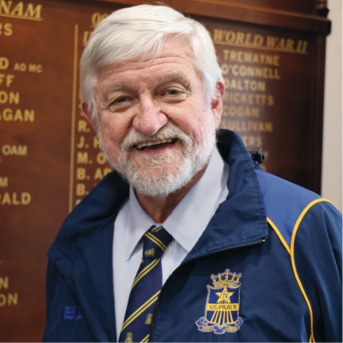
Seventy-five years ago, the news of Japanese atrocities against Prisoners of War (PW) outraged Australia. The pain continues to be felt today.4 A Sydney barrister, Russell Le Gay Brereton was the first to investigate and prosecute Japanese guards from one of the most notorious of the aptly described ‘death camps’ in North Borneo – Sandakan. This is the story of the establishing of the trials of those guards.
Background
Russell Le Gay Brereton was 26-years-old when he was admitted to the New South Wales Bar on 19 November 1937. He was tall, lean, dark haired and had achieved outstanding academic success. Brereton had been at the Bar for less than three years when he enlisted in the Australian Imperial Force (AIF) on 20 May 1940 as a private soldier (NX15837), joining the 2/2 Machine Gun Battalion5. During his time in the army he acquired the nickname Dooley, which stayed with him throughout his military and legal careers. ‘Mr Dooley’ was a well-known cartoon character at the time and Brereton’s fellow soldiers clearly saw some resemblance between the two.
Brereton embarked for overseas service in February 1941. He successfully completed promotion courses, often achieving high marks, and rose through the ranks. His ability was recognised while serving in the Middle East when he was appointed Temporary Captain and Aide De Camp to Major General Morshead6 in September 1942. Brereton was with Morshead throughout the Second Battle of El Alamein in late 1942. He wrote home of the ‘unforgettable experience’ of watching ‘incessant attack and counter-attack [of] an entire army in action [followed by] an unearthly peace’ after ‘twelve days of bedlam.’7
Brereton later returned to Australia for jungle training on the Atherton Tablelands in July 1943. In September 1943 he landed with his unit as part of the 9th Division at Lae. In November of the same year he was hospitalised with scrub typhus, which was ‘feared by the soldiers themselves more than any other disease.’8 Brereton never fully escaped the debilitating effects of this illness. He later re-joined his unit and was promoted Captain in November 1944.
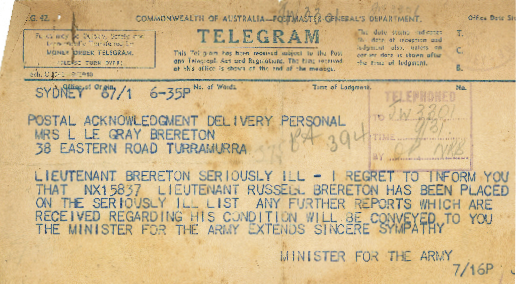
War Crimes Tribunal
Brereton landed with the 2/2nd MG Battalion on the island of Labuan off Brunei Bay to the north west of Borneo in early June 1945. It was oppressively hot and humid. The Australians worked closely with the local indigenous people, who gave the first reports of Australian PWs in the area. Brereton wrote that while they had not found any PWs themselves the locals were well aware of their situation and were ‘very sorry for them so it can’t be too good.’9 Soon the reports would provoke a storm of indignation against the Japanese. The situation was personal for Brereton as his brother Tom had been a PW since the fall of Singapore in 1942. Brereton would pore over lists of PWs to find out news about Tom.
On 11 July 1945 Brereton was appointed as War Crimes Officer for the 9th Division, thereby beginning an unexpected and significant period in his legal and military career. He was soon tasked with:
investigation, collecting evidence and prosecuting in all cases of collaboration with the Japs. . .The charges rang[ed] from murder to breaches of the Security Regulations, but the questions of the law to be tried under [was] rather difficult. [There were] about 100 of them [brought in] by loyal natives.10
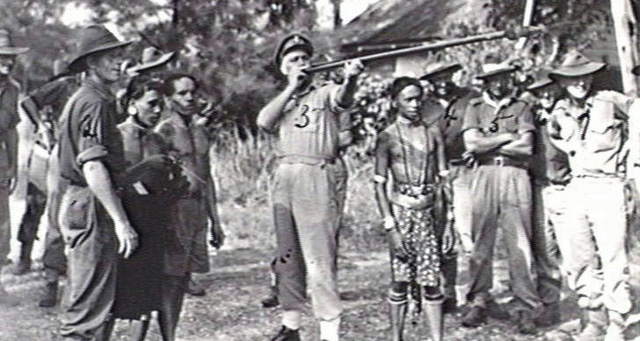
Brigadier WJV Windeyer with Dyaks trying a blowpipe - used with poisoned darts.
The war was in its final weeks but the details of what was to come were not known. On 6 August 1945 the first Atomic Bomb was dropped on Hiroshima and three days later a second on Nagasaki. Brereton reported the mood in the camp on Labuan in a letter home on 11 August 1945, four days before Emperor Hirohito announced the surrender of Japan.:
Last night – in the middle of a couple of chess games – it was announced that Japan was prepared to throw in the towel. There was no immediate reaction – nobody wanted to let himself think about it. We finished our games – one or two chaps drifted in and confirmed the news – no cheering. However, it sank in during the night and at breakfast, during the wireless announcement of the news, you could see an odd tear or two around the table, I think the relief made a lot of people feel more like crying than laughing.11
Soon after Brereton travelled up through Brunei to the country of the Dyaks, a group of local tribes. The official history of the time states that the Dyaks had been 'embarrassingly anxious to hunt down and slay Japanese' and then take their heads.12 Brereton observed this himself. He wrote that the Dyaks were:
a very proud race, and yet very shy – almost timid. . . . They’re gentle, kindly, hospitable and almost fanatically honest, and as to morals, they put the white races to shame.
Their peculiarity is of course head-hunting which is a sort of hobby, like stamp-collecting. The women are the prime movers in the matter and whenever they want a few more heads they turn on a head dance. All of the women of the village dance through it by torch light holding by the hair in each hand a head which peers this way and that. The men get so excited they go off and get more (avoiding any unnecessary risks). They smoke them and hang them in the huts.13
Brereton returned to Labuan and witnessed an event that would stay with him forever: the formal surrender of Lieutenant General Baba –Supreme Commander of 37th Japanese Army in North Borneo to General Wootten (Commanding Officer of the 9th Division).
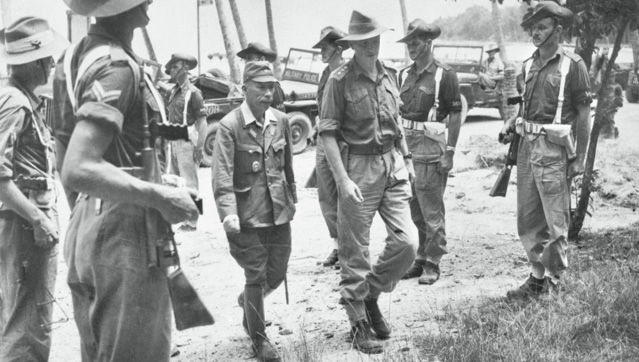
Lieutenant General Masao Baba - Supreme Commander of 37th Japanese Army in North Borneo on the way to surrender to General Wootten (Commanding Officer of the 9th Division)
The Jap Lt. General in command of Borneo [Baba] and his chief of staff came in to surrender. As a matter of fact, they’re living in a hut about 10 yards from my tent. They were marched from there to the General’s quarters closely shepherded by 8 six-footers with tommy-guns and passed a yard of a hundred men, which did not salute them, on the way. As they were both only about 5ft (if that) they must have felt rather small. They were then introduced to the General [Wootten], who is about 21 stone, and saluted him. He did not acknowledge the salute and ordered then to hand over their swords which they did. They then signed on the dotted and were marched away. Going in they looked quite happy and jaunty but coming out they were not so perky.14
Brereton wanted to find his brother Tom and go home, back to his legal career. He wrote to his mother to try and organise chambers for himself. His extensive war service gave him priority, but his departure was delayed as he was appointed to collect evidence for the War Crimes Trials on Labuan. These trials were ‘happenstance’ in that the combination of experienced personnel such as Brereton and the presence of Japanese accused and witnesses meant the trials could proceed near the places where the notorious events were alleged to have occurred, specifically at Kuching, Ranau and Sandakan.15
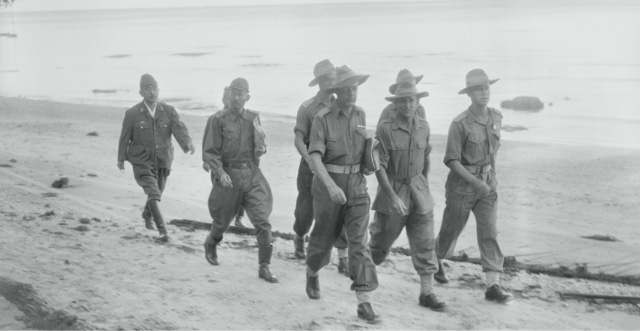
Brereton (front left) leads WO Sticpewich (to the left of Brereton) and Japanese Defence Counsel to the Trial of Sergeant Major Sugino, 3 December 1945. Labuan.
Brereton worked with Warrant Officer Bill Sticpewich who was a surviving witness of the Sandakan atrocities. Sticpewich and Brereton inspected the Japanese captives and identified suspected war criminals, some of whom Brereton interrogated. One interrogation was of Captain Susimi Hoshijima, the commander of the Allied PW compound at Sandakan who Brereton had identified among the Japanese PWs with Sticpewich.16
The work occurred against a background of outrage against the Japanese typified by statements in the press such as: 'The Japanese should be debarred from ever being recognised as a civilized nation because of their brutal, sadistic treatment of prisoners.'17 Brereton wrote that he was
interrogating Japs suspected of war crimes. So far I’ve kept my temper with them but don’t know how long it will last.
I had already written to Tom – to each of two possible addresses so he should get one. By the way – when he gets home don’t be sympathetic or sentimental – they’re [PWs] very touchy about it. Just act as if he’d been away for a while on normal duties. You’ll probably find him irritable and fernickety, but he’ll probably talk plenty if you leave him be. Don’t stop him but don’t lead him on and try to get him onto other subjects.
I’ll have to close now as I’m expecting a client called Yamamoto18. He tried to kill himself last night and another client19 succeeded in doing so a few days back.
Funny clients I have.20
Soon after Brereton flew to Kuching as part of his duties as investigator and stayed in the Rajah’s old palace in Sarawak which he found to be 'the last word in luxury. Marble bathrooms and all.'21 His work continued 'dealing mainly with the guards of the PW camps.' Kuching was in his words 'one of the moderately bad camps – only 600 out of 2,000 died.' He then had to move on to 'Sandakan' which was 'of course the worst in any area. Only 6 (who escaped) survived out of 2400'.22
Brereton combined his legal duties with the search for his brother. He hitched a ride from Kuching to Singapore, a trip which made him, in his own words, ‘a teeny-weeny bit AWOL [Absent Without Leave]',23 but he was keen to take the chance to try and find Tom. He visited Changi PW camp and searched the records there and established that Tom had left for Kuching only that morning! Brereton returned to Kuching and 'landed in a packet of trouble' as Divisional Headquarters 'were sending screaming messages' for him.24 His letters indicate that his cousin, Brigadier W J V (Victor) Windeyer DSO ED25 recognised Tom and facilitated the reunion.
Brereton returned to Labuan and reunited with his brother around 10 October. He described the scene:
Found Tom sitting on a bed talking to a cobber and looking reflectively at a practically full bottle of whisky. He looked up and said “where the hell have you been” I said “Get to work on that bottle – I’ve been chasing you through the equatorial skies”. . . . Well I supplied a few bits of red tape, got Tom out of hospital and brought him out here to live with me, where he is at the moment.26

Brereton’s work continued throughout October 1945.27 He wrote to his mother that while he was carefully collecting evidence he was not sure of the worth of the trials:
Things are . . . pretty busy and I seem to be well ahead of anyone else in the SWPA in the matter of tracking down Jap War Criminals.28 The list grows daily but we are arresting suspects slightly faster so the job will end sometime. I don’t know yet whether I’ll have to prosecute or not. It’s quite interesting at times but I’m getting a bit blasé and a mere murder or two cuts very little ice with me now.
I cannot see that punishing these Japs will do any good – it’s like punishing a monkey for adultery. Most of these PWs who had promised themselves that they would give the Japs a thorough hiding when they got out, feel nothing but contempt for the sniveling wretches and wouldn’t dream of hitting them, and the troops are inclined to regard them as children. The whole business is of course aggravated by the press and the mercurial views of the people who faced office chairs and comfortable jobs during the war. However, a few thousand less Japs won’t matter, a few million worthless hearts will rejoice in their deaths, and except for sowing the seeds of future acrimony no harm will be done.29
Brereton’s comments indicate that he had moved on from his initial distaste for the Japanese as an enemy and an emphasis on justice and understanding the nature of a crime and its context had moved to the fore. The issue of the trials as ‘Victors’ Justice’ continues until this day30.
Brereton was appointed as prosecutor in the first of the War Crimes Trials on Labuan, specifically the trial of Sgt Major Sugino Tsuruo (nicknamed the Jersey Bull because of his aggressive manner with PWs). Brereton went to great pains to ensure that the tribunal operated as closely as was possible to established legal forms.
A couple of Japs both graduates of Tokyo University and of Oxford ... will be the defending officers and I’m spending a bit of time instructing them on their court procedure and the system of British justice. They are pretty bright and should protect the interest of their clients pretty well. I hope they do, because there are twenty-six accused, most of whom are practically certain to qualify for the noose.31
By the way the above information is NOT for publication. I am afraid the home press may make a big show of the thing (not if I can help it) so the less you know the better.32
In addition to all my other duties I am responsible for the provision of a suitable courtroom and all the attendant detail. We were to have started the hearing on the 26th (of November) but this has now been delayed for a short time.33
On 3 December 1945 Brereton led a group of men that included the key witness for the prosecution, Bill Sticpewich, as well as the Japanese defence team along the beach of Labuan Island into the oppressively hot army tent for the trial. Around 50 Australian soldiers crowded under canvas. Brereton’s opening address suggests his concern for the legality of the unique situation. It read in part:
This Court is convened under the War Crime Act 1945.
Jurisdiction is described in Section 7 to 12 of the Act . . .
Accused is charged with the massacre of 46 Prisoners of War. . . . . They were all murdered on the spot. Sgt. SUGINO was asked why he did not attempt to stop it. He said he became so excited that he did not think of it. Accused then went to 5 ½ mile to intercept a party carrying stores, and the same thing occurred. All were shot and bayonetted to put them out of their misery. . . . I submit his act was a deliberate, calculated, cold-blooded murder.34
Sugino was found guilty and sentenced to death but Brereton impressed the Japanese defenders and officers with his concern for justice. The Japanese defending officer Yamada reportedly invited Brereton 'to be his guest in Japan 'when things settle down.''
The Australian Prosecutor apparently "smiled at the invite" but did not take it up.35
While Brereton was working hard on the trials, his mind was on his return home and his legal career. His last letter home from Labuan read in part:
... Had to put on a hell of a final sprint to be sure of finishing on time. Everyone has been very nice and helpful and I got thanked all round when I finished because we’re miles ahead of everyone else in completing the job. It only remains now to try the blighters. Who is going to finish that job, I don’t know and don’t care.36
He had had a long war.
Brereton left Borneo by plane on 1 January 1946 then flew, ‘thumb(ing) a lift’ in his words, via Darwin, Cairns, Townsville and Brisbane. He arrived in Sydney around midday on Tuesday 7 January 1946.37 He was discharged from the army on 25 January 1946. He was replaced on Labuan by Lieutenant Raymond Balzer, a young solicitor from Goulburn, and the Sydney barrister Athol Moffitt. At one stage there were two sets of trials prosecuted by these men on Labuan. 38 Much of the evidence used had been collected by Brereton.
Return Home
Brereton re-entered into the life of the Bar with great enthusiasm. He was a member of the Bar Council from 1947 until 1950. He also served in the CMF, 45th Battalion, and then at Headquarters 2nd Division on secondment to the Australian Army Legal Corps (AALC) until 1951. He remained close to his unit after the war and enjoyed attending their reunions ‘preferring to eat and drink with his platoon to eating and drinking with his commanding officer at the high table as his [later] status as a Judge justified.'39
Brereton was greatly affected by his war experiences. He worked with fellow barrister and war veteran, John Flood Nagle40, to collect the memoirs of those people from the Sydney University Law School who served in the war. His sense of commitment to the comradeship of war led to his energetic support for Legacy.
One particularly poignant object remained as tangible reminder of Brereton’s time on Labuan. The day before he left the tropic island the Japanese Lieutenant General Baba presented him with a parting gift: Japanese calligraphy written in thick brush strokes on rice paper. The translation and dedication on the reverse side read:
True heart is the core of everything
Dedicated to Captain Brereton ESQ.
War Crimes Officer of 9th. Australian Division.
From. Lt-General Masao Baba. Supreme Commander of 37th Japanese Army in North Borneo.
29th December. 1945. Labuan. North Borneo.
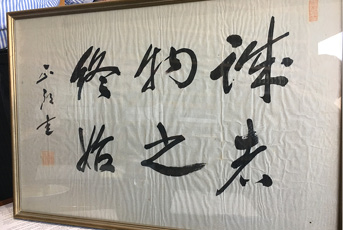
The gift hung in Brereton’s Chambers for decades. Baba was found guilty of Command responsibility for the Sandakan Death March and executed by hanging 7 August 1947, just on two years after Brereton had seen him arrive by plane to surrender to General Wootten on Labuan on 10 September 1945. By then Brereton was practising out of Chambers at 182 Phillip Street mainly in landlord and tenancy, bankruptcy and divorce proceedings. At the end of 1947 he was appointed Crown prosecutor in the Yass Wagga district of New South Wales.
On 19 July 1951 Brereton was appointed a Judge of the District Court of New South Wales and a Chairman of Quarter Sessions for the South-western District. At the time he was the youngest judge to be appointed to the District Court. On 11 September 1952 he was made an Acting Judge of the Supreme Court of New South Wales for three months. On 13 October 1952 he was appointed a permanent Puisne Judge, serving until his death in 1974. He was described as ‘fair-minded’ but with a forbidding presence.’41
Brereton’s only prosecution, the Jersey Bull, Sergeant Major Sugino was executed by hanging on Morotai on 3 March 1946 – one of many who had so badly mistreated Allied PWs on Borneo during the Second World War.
ENDNOTES
1 Judge of the Supreme Court of New South Wales from 1952 until 1974. Known by all as ‘Dooley’.
2 The author acknowledges the great support of the Hon Justice Paul Brereton AM RFD for his advice and permission to quote from the letters and private papers of the Brereton family, as well as the Hon Michael Kirby AC CMG and the staff at St Pius X College for their comments and encouragement.
3 Head of Publications St Pius X College Chatswood. Member Francis Forbes Society for Australian Legal History.
4 A number of politicians and school students including the current Prime Minister, Scott Morrison, walked part of the route of the Death March with a commemorative party in 2016.
5 The unit operated .303 Vickers Machine Guns – a devastating weapon when used in defence against attacking troops. These guns had caused carnage on the battlefields of the Western Front in the First World War.
6 General Officer Commanding 9th Division.
7 Brereton, ‘Echoes from El Alamein’ in Legal Digest No. 9. 31 March 1943, 2. The Legal Digest was a newsletter disseminated among lawyers by the Sydney University Law School Comforts Fund during the war.
8 Allan S Walker Clinical Problems of War. Australia in the war of 1939-1945 Australian War Memorial, 1956. pp 178. Canberra.
9 Brereton 2 July 1945. 2. All letters quoted here were sent by Russell Le Gay Brereton to home during the war.
10 Brereton 25 July 1945, 1- 2. The list is in the War Diary of the 9th Division for December 1945.
11 Brereton 11 August 1945, 2.
12 Gavin Long The Final Campaigns. Australian War Memorial, Canberra (1963), 490.
13 Brereton 28 August 1945, 1-2.
14 Brereton 10 September 1945, 1-2.
15 Georgina Fitzpatrick, Tim McCormack and Narrelle Morris (eds), Australia’s War Crimes Trials 1945-51, Leiden: Brill Nijhoff, 2016. 446 - 447.
16 Available online at National Australian Archives at Statements and Interrogation Reports: https://recordsearch.naa.gov.au/SearchNRetrieve/Interface/ViewImage.aspx?B=392416 Hoshijima was later tried and found guilty of war crimes and executed by hanging on Rabaul 6 April 1946.
17 “Japanese Have Lost Right to Civilised Status”. Sydney Morning Herald 12 September 1945, 3.
18 Lieutenant Surgeon Yamamato Katsuji who had refused medical supplies to PWs. Sentenced to death by firing squad. Executed Morotai 6 March 1946. See Fitzpatrick 437.
19 Lieutenant Colonel Tatsuji Suga, Commander of Kuching Camp who committed suicide Labuan 16 September 1945.
20 Brereton 22 September 1945, 1-2.
21 Brereton 1 October 1945, 1.
22 Brereton 1 October 1945, 1 - 2.
23 Brereton 12 October 1945, 3.
24 Brereton 12 October 1945, 3.
25 Later Maj.Gen the Hon Mr Justice Sir Victor Windeyer of the High Court of Australia.
26 Brereton 12 October 1945, 3.
27 Brereton 26 October 1945, 1.
28 Other investigations were on Morotai and Rabaul. The first trial on Morotai commenced 29 November 1945.
29 Brereton 26 October 1945, 1.
30 See for example the Hon Michael Kirby AC CMG. Soldier Judges and Australia’s War Crimes Trials Unpublished Paper, Sydney 2016, courtesy of the author. A more detailed account is Narrelle Morris and Tim McCormack ‘Were the Australian Trials Fair?’ in Georgina Fitzpatrick et al, 781 – 809.
31 In all, 225 death sentences were imposed in Australian War Crimes Trials and some 137 were carried out.
32 Press condemnation of the Japanese became increasingly shrill at the time.
33 Brereton 23 November 1945, 1.
34 Address by Prosecutor, Captain R Le Gay Brereton. Available online at National Archives of Australia. https://recordsearch.naa.gov.au/SearchNRetrieve/Interface/ViewImage.aspx?B=692437.
35 Eric Thornton ‘Jap Lawyer Invites Prosecutor To Be His Guest in Japan’ Argus 7 December 1945, 20.
36 Brereton 30 December 1945, 1.
37 Brereton m 2 – 6 January 1946, 1.
38 Fitzpatrick, 448 – 449.
39 A H Loxton Assembly to pay Tribute to the Memory of the Honourable Mr Justice Russell Le Gay Brereton. Supreme Court of New South Wales. Banco Court. 10 May 1974.
40 Later a Judge of the Supreme Court of New South Wales from 1960 until 1983.
41 Kirby, 20.